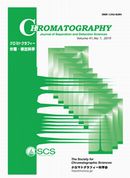Volume 41, Issue 2
Displaying 1-7 of 7 articles from this issue
- |<
- <
- 1
- >
- >|
Original Papers
-
Article type: research-article
2020 Volume 41 Issue 2 Pages 63-71
Published: June 20, 2020
Released on J-STAGE: July 06, 2020
Advance online publication: March 03, 2020Download PDF (1100K) -
Article type: research-article
2020 Volume 41 Issue 2 Pages 73-78
Published: June 20, 2020
Released on J-STAGE: July 06, 2020
Advance online publication: April 15, 2020Download PDF (1681K) -
Article type: research-article
2020 Volume 41 Issue 2 Pages 79-84
Published: June 20, 2020
Released on J-STAGE: July 06, 2020
Advance online publication: May 27, 2020Download PDF (692K)
Short communications
-
Article type: research-article
2020 Volume 41 Issue 2 Pages 85-89
Published: June 20, 2020
Released on J-STAGE: July 06, 2020
Advance online publication: February 22, 2020Download PDF (400K) -
Article type: research-article
2020 Volume 41 Issue 2 Pages 91-95
Published: June 20, 2020
Released on J-STAGE: July 06, 2020
Advance online publication: April 24, 2020Download PDF (615K) -
Article type: research-article
2020 Volume 41 Issue 2 Pages 97-101
Published: June 20, 2020
Released on J-STAGE: July 06, 2020
Advance online publication: April 24, 2020Download PDF (512K) -
Article type: research-article
2020 Volume 41 Issue 2 Pages 103-107
Published: June 20, 2020
Released on J-STAGE: July 06, 2020
Advance online publication: May 27, 2020Download PDF (523K)
- |<
- <
- 1
- >
- >|
